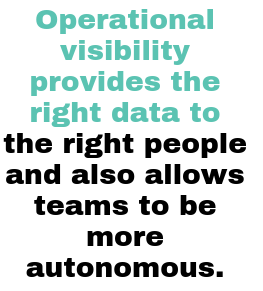With DevOps practices, many companies have improved their CI/CD pipeline, ensuring that deployments happen smoothly and frequently. In addition, many companies have added automated testing and application monitoring to make sure their apps work consistently and within spec.
Unfortunately, many companies stop there and don’t take further actions to improve operational visibility. Additional tooling and infrastructure for metrics and logs don’t always have clear benefits. Therefore, many companies deprioritize these efforts in favor of more features.
However, you’re missing out on a lot of benefits if you just stop with the basics of DevOps. A successful deployment is only one step in the process. But if you stop there, you’re don’t get the data that can provide more positive benefits for your customers. And more benefits for your customers can lead to better competitiveness in the market.
Let’s look at operational visibility and see how it can give your company and products the edge over the competition.

Operational Visibility
Operational visibility refers to the monitoring of your system’s operations, performance, and readiness. It allows you to assess fluctuations in metrics and act on anomalies.
Many businesses continue to act with little operational visibility. They find out about problems from their customers. However, some problems never bubble up to the surface because affected users may simply go away without commenting on their experience.
So you shouldn’t just stop where your CI/CD pipeline ends. But where do you go now? The next step involves adding operational visibility to your platform. Once you know your application made it into production, you’ll want to know more than just how well it’s running. You also want to know what the system traffic looks like because that’ll help you get into the minds of your customers and find out what they’re actually doing with your products.
Competitiveness
Now that you know a bit more about operational visibility, how can it improve your competitiveness? In the next few sections, let’s look at how data from our application and business operations can give you an edge.
The Features and Fixes That Customers Need
With increased operational visibility, you can track which features your customers gravitate toward in our applications and where they have problems or run into errors. This insightful additional data can drive your application teams to focus on the features that customers actually want and use.
Using all this data, you can plan our product launches so that you launch with the most critical bug fixes and most important features first.
Additionally, you can increase the speed with which you go to market with these features and fixes. Those additional metrics and insights will provide a better view of how your systems are used and will alert you to problems quickly if there’s a need to backtrack.
Decentralized Decision-Making for a Faster Turnaround
With more visibility into the operations of your systems, your teams can make more decisions themselves. If a feature seems to be taking off quickly, perhaps a team can find a way to capitalize on the success right away instead of waiting until the next product meeting.
Decentralized decision-making brought about by increased operational visibility will provide a competitive edge where responsiveness and speed count.
Better Customer Support
Operational visibility provides the right data to the right people and also allows teams to be more autonomous. If your customer support folks can quickly answer questions by looking into metrics or logs of an application, they will route fewer calls down to product teams or developers. They’ll be able to help customers within minutes instead of hours or days.

And with just a few of these competitive advantages, you can start separating yourself from similar products and applications that don’t focus on daily operations and trends. But how do you add all this visibility into your world? Let’s take a deeper look.
What Do You Need?
So let’s say you’re ready to take the plunge into operational visibility. What would your next steps be? Well, you need to work on a few things to make sure you’re able to get what you need out of our systems and processes. Let’s go through some of these steps.
Robust Data Collection
For the first step of operational visibility, you need data. And lots of it. Additionally, you need systems that can handle the load of storing and accessing all that data.
With Scalyr, the answer is simple. You can use logging for all your data needs and access it quickly. And it’s not enough that you log all the things. You also need to make sure that everyone that needs access can have it.
Though it takes skill to write the code that runs your system, it doesn’t take as much skill or experience to be able to read a log message and determine what’s going on. That’s especially true if your developers understand the value of the logs and add more user-friendly logging wherever they can.
So however you decide to gather your operational metrics and messages, make sure you’re set up to handle the load on resources.
Alignment Between KPIs and the Data Collected
Whatever your business KPIs involve, there should be data collected that correlates to them. So if your product KPIs involve sales figures, conversions, or time spent on a page, then your operational visibility tool should also have access to that data as it relates to your products.
For example, it’s no longer enough to have monthly or weekly reports on sales figures. You need these figures in real time. And if you gather those figures in real time using operational visibility tools, you can monitor the health of your company with better speed and accuracy.
So any time you’re tracking KPIs for business, make sure you have visibility into the data that supports these KPIs.
Accurate Data
All the data that you’re gathering and tracking towards KPIs doesn’t add value if it’s inaccurate. In order to make the best decisions around your competitiveness, you need to know that your data reflects reality.
So in addition to testing around your business logic, you need testing around your visibility metrics. You don’t want to find out too late that a bug reports the wrong values for your KPI.
Visibility
Visibility can come in many forms. It can include fancy dashboards and alerting. Or it can involve providing the proper access to logs and metrics.
But the important thing about visibility involves actually making the data visible. And most companies stop short of providing the data to all the employees that can benefit from it.

For example, you may think that only developers and application maintenance folks need access to logs. But you’re not considering that your customer support, social media, or marketing people could use access too.
Giving visibility to operational metrics can provide your employees with data that they can use in ways you can’t even imagine. They can speed up support, find new ways to market features, or spot trends that you’re not tracking.
Compete by Using Data
Instead of stopping with the easy wins brought by automated testing and a CI/CD pipeline, go further to build visibility into the operation of your applications and business.
You’ll be able to react faster, improve support, and provide what other companies won’t. And with all these features, your teams will benefit from the ability to make decisions autonomously with real-time data.
So take a look at Scalyr and give it a spin. See how you can make your product more competitive and successful using operational visibility.


